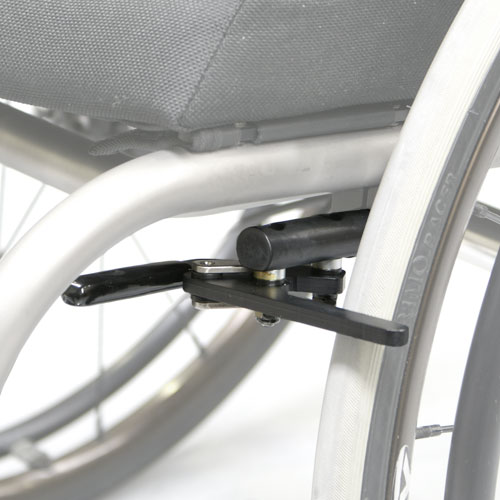I have been using basic manual wheels for the past 4 months. While being ‘handy’ doing light maintenance such as: checking for loose screws/bolts, tire pressure, cleaning the frame, cleaning the ball bearings from the caster wheels in the front from hair, and replacing worn-out pieces- the thing is constant upkeep.
On top of all I have mentioned, ‘brakes’ are the most relied on by every person with FA. I am thinking that I stand up at least 30-50 times a day. Transferring to the car, out of bed, going to the restroom, kitchen grabbing/reaching, brushing my teeth/doing dishes standing up, doing squats, dropping things I cannot reach sitting down, ugh the list goes for ever! Putting on the breaks requires me to shift all my weight on my arms awkwardly to my wrists. Believe it or not I can tell this repetitive task does more harm to my shoulders than just pushing myself.
There are two standard breaks for manual wheelchairs.
Push to lock

Scissor lock

I have scissor lock breaks. Both style breaks only work when the person using it is not grasping onto the chairs frame for safety/assurance. In my opinion they are not locks, rather they stop the wheels while not touching the chair. When I hold the frame while transferring they might as well not exist.
I don’t have to explain much to anyone with ataxia, but to the outsiders; ataxia means I need to grab/hold/grasp onto things that are attached to walls and/or something that cannot fail if my whole body weight shifts unexpectedly when I am on my two feet. I can tell you in 2010 I was walking slowly with 2 concrete bags in a shopping cart as a counter weight and I still managed to flip it over.
Again, scissor locks or push to lock locks only work when appropriate air is in the tires, adjusted right (3 sets of 37-540 or 24” wheels are not the same!), tread is not worn, and above all rain. Everything can be adjusted right- but as soon as wheelchair tires get wet, brakes do not work. Thus resulting me falling and getting my bottom wet. Here in the Pacific Northwest it rains all the time! Frustrating.
I did a lot of research of alternative solutions and I found 3:
1 ——AVI’s disk brake for manual wheelchairs.

2 ——D’s Locks Pin disk system.

3 ——SurelockInc – pin-lock system.

Okay so my opinion on all 3:
ADI makes actual disk brake hubs for manual wheelchairs. When I began to ponder the idea that there has to be a better braking system out in the world this product came to mind. It seems ambiguous on how it works on the wheels. I understand the Chamber Tube, Quick Axle Button/Sleeve. I see where if a wheelchair user had limited hand control while going down a hill could benefit from this, but my handgrip strength is still good enough to help me go down ramps. The company is based in Texas and has full page ads in MDA’s Quest magazine (I got a copy last month by mail.) It is cool MSRP is about one thousand, but the disk brake seems too much.
D’s Lock
They are based in the San Diego area and seems like they are the choice everyone gets. They are obviously the cheapest (at or around 500 MSRP) Called me unique, but I choose to lead my own path. Working in retail for a decade (and throughout life in general) I had learned you truly get what you pay for. Rutgers University’s Care Forum has the 2nd post show a guy has bought 5 sets for one chair! Did it break? The cable is an issue as users have had to get it replaced.
SurelockInc
I choose the Surelock system; small company in rural Kansas to custom make me a pin-lock setup for my chair. I read forums about each system from others and even though Surelock costs a little more (about one thousand MRSP), I have read post after post that Surelock locks are better quality, more precise pinholes than D’s. Rutgers University has a great Care Forum: this post, gives a users’ opinion when he installed D’s with ¾” to 1/2” play in the pistons. Surelock maybe upto ½” play (from 9th post on this Care Forum.) Surelock’s hubs have 27 position stops; D’s has 24. The only major con with Surelock is the locking lever; users on the Care Forum explain it is bulky compared to D’s.
The company is located in Lewis, Kansas, roughly 60 miles east of Wichita. It is so rural that I cannot call them through my cellphone (my carrier works perfectly for everything else. For some reason I can only talk to Jack Roberts through a landline.
Now the pin-lock system is being made right now and will take a few weeks until I actually receive it, so I will review it in the following posts in a few weeks.
The best thing about this system is when I receive it is no more playing a game of sit/flop onto the wheelchair before it rolls away or thinking about the struggle to put my locks on during my daily living activities. The frame weighs maybe 15 pounds tops; so a power chair with weight would make since, but I want to avoid that until I absolutely need one. In the end I know not every system in life will last forever, but this will make one annoyance in my life easier.
